You are using an out of date browser. It may not display this or other websites correctly.
You should upgrade or use an alternative browser.
You should upgrade or use an alternative browser.
Isn't that a lot more work?
- Thread starter Dustin07
- Start date
I'm two coffees into my morning and still a little lost. I had to read that a couple times, Tim. I'm hearing that my algae reactor could probably be traded/sold off. it sounds almost like it could be more negative than positive for the tank?
"What saves corals are the cryptic sponges that remove DOC a thousand times faster than the bacterioplankton (30 minutes vs 20 days) that might be removed by skimmers"
can you walk me through that? I grabbed the links you posted but be patient with me those are long reads so I'll have to come back to them, lol. I'm not sure if I'm understanding your stance on protein skimmers from this statement. the past 3 years I have had nothing more than a natural rock / sand/ CUC with essentially a sponge filter setup that I'd occasionally update/clean, and felt like I had things pretty under control with my corals growing, spreading, and my fish starting to breed. So I've been very excited about the additional water of the sump, the reefmat and protein skimmer for the perceived water quality improvement but now I'm really wondering what the best solution here is, lol.
What's happening with DOC in reef ecosystems is VERY COMPLICATED! There's hundreds of researchers looking at what's going on with DOC and bacteria and archaea (single cell stuff that aren't bacteria) and fungii and phages (viruses that attach archaea and bacteria). I don't ever expect to be able to wrap my head around all of it. (In fact, a significant majority of the stuff that falls under the label of "DOC" is still "undifferentiated", not defined,) If you can find a copy of Forest Rohwer's "Coral Reefs in the microbial Seas" it is an excellent introduction to the conflicting roles of DOC, algae and corals. The University of California put out a video by Rohwer which compliments his book, but I'd encourage you get his book as it covers some of the initial research not looked at in his video. (You may be able to borrow a copy online from Archive.org.)
In a nutshell, bacteria and archaea processes are strongly influenced by DOC (aka carbon dosing). The effects of DOC are species specific, ie, the "species" or type DOC has species specific effects on bacteria and archaea and those in turn have species specific effects on corals. The paper by Kline, et al, I linked to in my previous post besides showing the species specific effects of DOC also showed excess DOC of the coral that produced it had an negative effect when reap to that coral. Finally, algae produces far more DOC than corals.
More recent work by research has shown DOC affects corals in two basic ways. First, it promotes pathogenic shifts in coral microbiomes (I should mention coral microbiomes are species specific and research on coral immune systems shows genotyupe specific variables). Second. excess DOC can create annoxic conditions in the boundery layer around corals esentially suffocating them (this boundary layer is only a few mm thick).
From what I've over the years cryptic sponges are ubiquitous in reef systems. When ever I've moved or reaquascaped a system there have been cryptic sponges. Steve Tyree started promoting them for filtration back in the '90s. It's de Goeig's work that showed how essential they are for corals and the food webs in reef ecosystems One of de Goeig's discoveries was at least some of these cryptic sponges have a mitosis rate of just 6-8 hours. But instead of growing at some phenominal rate, they are shedding huge amounts of cellular detritus rich in nutrients back into the ecosystem. This process of converting DOC into particulate detritus explains why coral aren't killed in short order by algae scrubers or by adding DOC to promote bacterial growth to be removed by skimmers.
On the face of it skimmers might seem like a good idea as they are removing bacterioplankton from the water column even if the bacteria and archaea are feeding off secondary stuff and not directly off DOC as is assumed with carbon dosing. The microbial and protein waste in reef systems can be divided into stuff that's hydrophillic and stuff that's hydrophobic. Unfortunately, skimmers are only removing stuff that has a hydrophobic nature. One way or another skimmers are skewing the microbial species in the water and disrupting the processes that are promoting stuff beneficial for corals. More importantly, a subset of DOC labeled Dissolved Combined Neutral Sugars (DCNS) has been identifed as the primary culprits causing problems with cotrals and they are not removed by skimmers, or GAC for that matter.
So, short answer, don't use a skimmer, don't carbon dose and don't grow algae. Do frequent water chagnes (20% - 30% monthly) as that's the only way to reduce stuff equally
I'm two coffees into my morning and still a little lost. I had to read that a couple times, Tim. I'm hearing that my algae reactor could probably be traded/sold off. it sounds almost like it could be more negative than positive for the tank?
"What saves corals are the cryptic sponges that remove DOC a thousand times faster than the bacterioplankton (30 minutes vs 20 days) that might be removed by skimmers"
can you walk me through that? I grabbed the links you posted but be patient with me those are long reads so I'll have to come back to them, lol. I'm not sure if I'm understanding your stance on protein skimmers from this statement. the past 3 years I have had nothing more than a natural rock / sand/ CUC with essentially a sponge filter setup that I'd occasionally update/clean, and felt like I had things pretty under control with my corals growing, spreading, and my fish starting to breed. So I've been very excited about the additional water of the sump, the reefmat and protein skimmer for the perceived water quality improvement but now I'm really wondering what the best solution here is, lol.
My answer was too big so here's the second part.
And here's a huge data bomb. Most of the papers will have additional links if you need more rabbit holes to go down.
Videos
"Coral Reefs in the Microbial Seas " This video compliments Rohwer's book of the same title. Used copies are available on line and it may be free to read on Internet Archive. both deal with the conflicting roles of the different types of DOC (carbon dosing) in reef ecosystems and how it can alter coral microbiomes. While there is overlap bewteen his book and the video both have information not covered by the other and together give a broader view of the complex relationships found in reef ecosystems and are an excellent starting point to understand the conflicting roles of Dissolved Organic Carbon (DOC, aka "carbon dosing") in reef ecosystems.
Changing Seas - Mysterious Microbes
Microbial view of Coral Decline
Nitrogen cycling in hte coral holobiont
BActeria and Sponges
Maintenance of Coral Reef Health (refferences at the end)
- YouTube
Optical Feedback Loop in Colorful Coral Bleaching
- YouTube
DNA Sequencing and the Reef Tank Microbiome
- YouTube
Richard Ross What's up with phosphate"
- YouTube
DOC stuff
Global microbialization of coral reefs, Rohwer's DDAM theory proof.
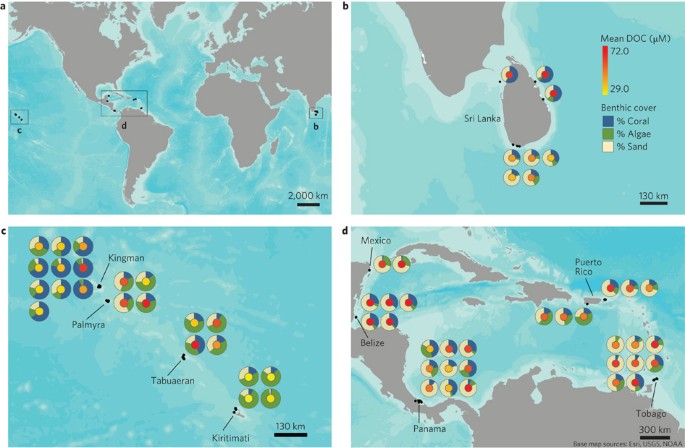
Global microbialization of coral reefs - Nature Microbiology
Analysis of 60 sites in three ocean basins suggests that overgrowth of fleshy algae on coral reefs supports higher microbial abundances dominated by copiotrophic, potentially pathogenic bacteria via the provision of dissolved inorganic carbon.
Indirect effects of algae on coral: algae‐mediated, microbe‐induced coral mortality
Influence of coral and algal exudates on microbially mediated reef metabolism.
Coral DOC improves oxygen (autotrophy), algae DOC reduces oxygen (heterotrophy).
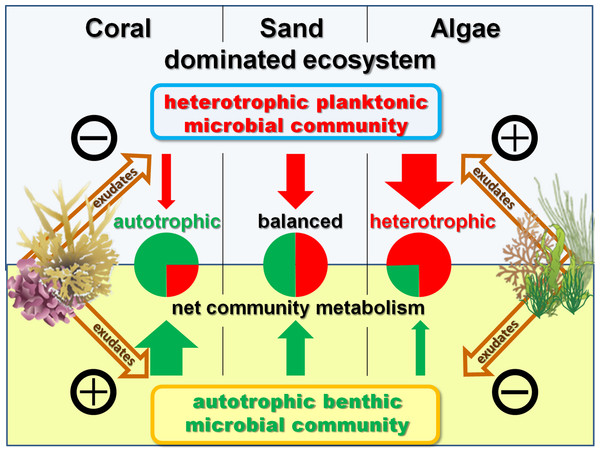
Influence of coral and algal exudates on microbially mediated reef metabolism
Benthic primary producers in tropical reef ecosystems can alter biogeochemical cycling and microbial processes in the surrounding seawater. In order to quantify these influences, we measured rates of photosynthesis, respiration, and dissolved organic carbon (DOC) exudate release by the dominant...
Role of elevated organic carbon levels and microbial activity in coral mortality
Effects of Coral Reef Benthic Primary Producers on Dissolved Organic Carbon and Microbial Activity
Algae releases significantly more DOC into the water than coral.
Effects of Coral Reef Benthic Primary Producers on Dissolved Organic Carbon and Microbial Activity
Benthic primary producers in marine ecosystems may significantly alter biogeochemical cycling and microbial processes in their surrounding environment. To examine these interactions, we studied dissolved organic matter release by dominant benthic taxa and subsequent microbial remineralization in...
Pathologies and mortality rates caused by organic carbon and nutrient stressors in three Caribbean coral species.
DOC caused coral death but not high nitrates, phosphates or ammonium.
Visualization of oxygen distribution patterns caused by coral and algae
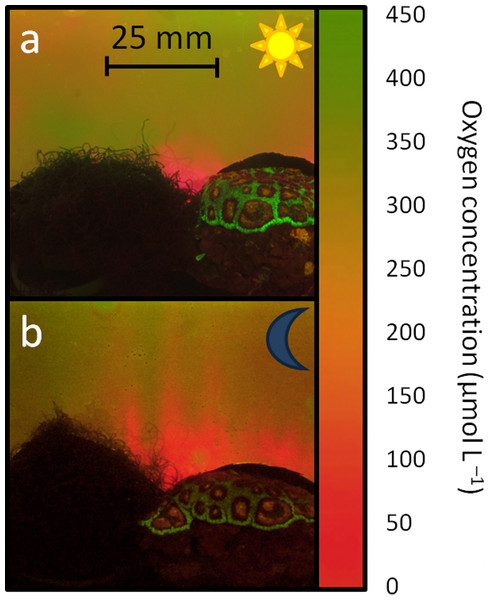
Visualization of oxygen distribution patterns caused by coral and algae
Planar optodes were used to visualize oxygen distribution patterns associated with a coral reef associated green algae (Chaetomorpha sp.) and a hermatypic coral (Favia sp.) separately, as standalone organisms, and placed in close proximity mimicking coral-algal interactions. Oxygen patterns were...
Biological oxygen demand optode analysis of coral reef-associated microbial communities exposed to algal exudates
Exposure to exudates derived from turf algae stimulated higher oxygen drawdown by the coral-associated bacteria.
Biological oxygen demand optode analysis of coral reef-associated microbial communities exposed to algal exudates - PMC
Algae-derived dissolved organic matter has been hypothesized to induce mortality of reef building corals. One proposed killing mechanism is a zone of hypoxia created by rapidly growing microbes. To investigate this hypothesis, biological oxygen ...
Microbial ecology: Algae feed a shift on coral reefs
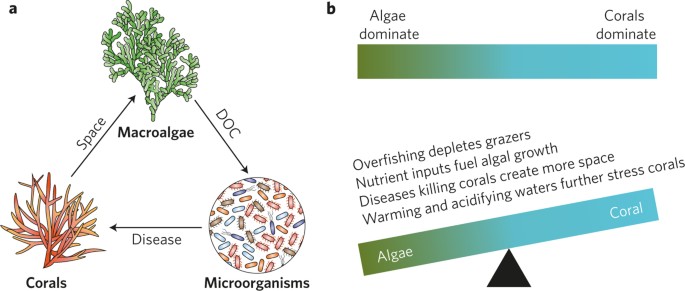
Microbial ecology: Algae feed a shift on coral reefs - Nature Microbiology
Human pressures on coral reefs are giving macroalgae a competitive advantage over reef-building corals. These algae support larger, and potentially pathogenic, microbial populations that are metabolically primed for less-efficient, yet faster, carbohydrate remineralization, perpetuating a...
Coral and macroalgal exudates vary in neutral sugar composition and differentially enrich reef bacterioplankton lineages.

Coral and macroalgal exudates vary in neutral sugar composition and differentially enrich reef bacterioplankton lineages - PubMed
Increasing algal cover on tropical reefs worldwide may be maintained through feedbacks whereby algae outcompete coral by altering microbial activity. We hypothesized that algae and coral release compositionally distinct exudates that differentially alter bacterioplankton growth and community...
Sugar enrichment provides evidence for a role of nitrogen fixation in coral bleaching
Elevated ammonium delays the impairment of the coral-dinoflagellate symbiosis during labile carbon pollution
(here's an argument for maintaining heavy fish loads if you're carbon dosing)
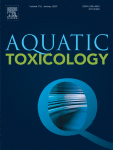
Elevated ammonium delays the impairment of the coral-dinoflagellate symbiosis during labile carbon pollution
Labile dissolved organic carbon (DOC) is a major pollutant in coastal marine environments affected by anthropogenic impacts, and may significantly con…
Excess labile carbon promotes the expression of virulence factors in coral reef bacterioplankton
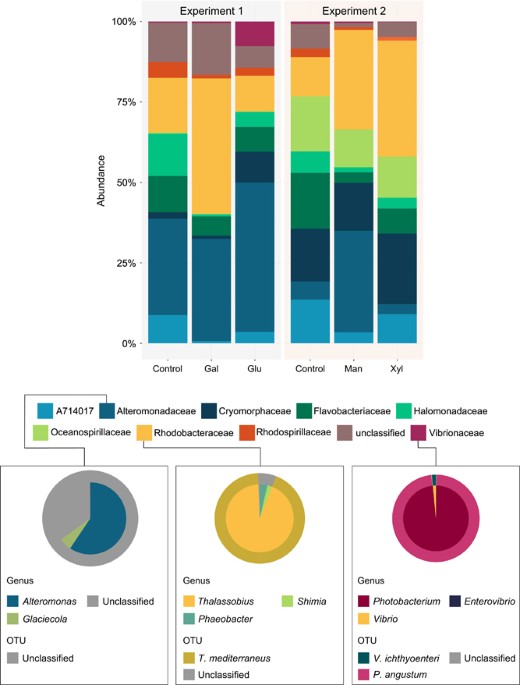
Excess labile carbon promotes the expression of virulence factors in coral reef bacterioplankton - The ISME Journal
Coastal pollution and algal cover are increasing on many coral reefs, resulting in higher dissolved organic carbon (DOC) concentrations. High DOC concentrations strongly affect microbial activity in reef waters and select for copiotrophic, often potentially virulent microbial populations. High...
Unseen players shape benthic competition on coral reefs.

Unseen players shape benthic competition on coral reefs - PubMed
Recent work has shown that hydrophilic and hydrophobic organic matter (OM) from algae disrupts the function of the coral holobiont and promotes the invasion of opportunistic pathogens, leading to coral morbidity and mortality. Here we refer to these dynamics as the (3)DAM [dissolved organic...
Allelochemicals Produced by Brown Macroalgae of the Lobophora Genus Are Active against Coral Larvae and Associated Bacteria, Supporting Pathogenic Shifts to Vibrio Dominance.

Allelochemicals Produced by Brown Macroalgae of the Lobophora Genus Are Active against Coral Larvae and Associated Bacteria, Supporting Pathogenic Shifts to Vibrio Dominance - PubMed
Diverse microbial communities associate with coral tissues and mucus, providing important protective and nutritional services, but once disturbed, the microbial equilibrium may shift from a beneficial state to one that is detrimental or pathogenic. Macroalgae (e.g., seaweeds) can physically and...
Macroalgae decrease growth and alter microbial community structure of the reef-building coral, Porites astreoides.

Macroalgae decrease growth and alter microbial community structure of the reef-building coral, Porites astreoides - PubMed
With the continued and unprecedented decline of coral reefs worldwide, evaluating the factors that contribute to coral demise is of critical importance. As coral cover declines, macroalgae are becoming more common on tropical reefs. Interactions between these macroalgae and corals may alter the...
Macroalgal extracts induce bacterial assemblage shifts and sublethal tissue stress in Caribbean corals.

Macroalgal extracts induce bacterial assemblage shifts and sublethal tissue stress in Caribbean corals - PubMed
Benthic macroalgae can be abundant on present-day coral reefs, especially where rates of herbivory are low and/or dissolved nutrients are high. This study investigated the impact of macroalgal extracts on both coral-associated bacterial assemblages and sublethal stress response of corals. Crude...
Biophysical and physiological processes causing oxygen loss from coral reefs.
Coral Reef Microorganisms in a Changing Climate, Fig 3
Figure - PMC
Coral reefs are one of the most diverse and productive ecosystems on the planet, yet they have suffered tremendous losses due to anthropogenic disturbances and are predicted to be one of the most adversely affected habitats under future climate ...
Ecosystem Microbiology of Coral Reefs: Linking Genomic, Metabolomic, and Biogeochemical Dynamics from Animal Symbioses to Reefscape Processes
Sponge stuff
Element cycling on tropical coral reefs.
This is Jasper de Geoij's ground breaking research on reef sponge finding some species process labile DOC 1000X faster than bacterioplankton. (The introduction is in Dutch but the content is in English.)
Sponge symbionts and the marine P cycle
Phosphorus sequestration in the form of polyphosphate by microbial symbionts in marine sponges
Differential recycling of coral and algal dissolved organic matter via the sponge loop.
Sponges treat DOC from algae differently than DOC from corals
A Vicious Circle? Altered Carbon and Nutrient Cycling May Explain the Low Resilience of Caribbean Coral Reefs

A Vicious Circle? Altered Carbon and Nutrient Cycling May Explain the Low Resilience of Caribbean Coral Reefs
Coral reefs are economically important ecosystems that have suffered unprecedented losses of corals in the recent past. Why have Caribbean reefs in particu
Surviving in a Marine Desert The Sponge Loop Retains Resources Within Coral Reefs
Dissolved organic carbon and nitrogen are quickly processed by sponges and released back into the reef food web in hours as carbon and nitrogen rich detritus.
Natural Diet of Coral-Excavating Sponges Consists Mainly of Dissolved Organic Carbon (DOC)
Natural Diet of Coral-Excavating Sponges Consists Mainly of Dissolved Organic Carbon (DOC) - PMC
Coral-excavating sponges are the most important bioeroders on Caribbean reefs and increase in abundance throughout the region. This increase is commonly attributed to a concomitant increase in food availability due to eutrophication and pollution. ...
The Role of Marine Sponges in Carbon and Nitrogen Cycles of COral Reefs and Nearshore Environments.
The role of marine sponges in carbon and nitrogen cycles of coral reef and nearshore environments - ProQuest
Explore millions of resources from scholarly journals, books, newspapers, videos and more, on the ProQuest Platform.
Microbially mediated nutrient cycles in marine sponges
Misc
Manual removal and urchins to contral algae
To Save Corals in an Oahu Bay, First Vacuum up Invasive Algae, Then Apply Sea Urchins | response.restoration.noaa.gov
Aura-biomes are present in the water layer above coral reef benthic macro-organisms

Aura-biomes are present in the water layer above coral reef benthic macro-organisms - PubMed
As coral reef habitats decline worldwide, some reefs are transitioning from coral- to algal-dominated benthos with the exact cause for this shift remaining elusive. Increases in the abundance of microbes in the water column has been correlated with an increase in coral disease and reduction in...
OMG Tim, I'll be coming back to and rereading all of this many many times, thank you so much for the amount of work you put into sharing all that information. It will take me some processing!!!!
This part is cracking me up because it seems like this is why my previous tank did so well. It's almost like I just got lucky. There was nearly zero filtration, just good water flow and weekly water changes of about 10%+ which I did because for one thing, I enjoyed tinkering with the tank, and on the other hand I felt like fresh salt was replenishing trace minerals the corals were absorbing. I had never used carbon or a skimmer, much less an algae reactor.
Now, one thing I was excited about in regards to all these new toys on the Reefer 425 was a perceived improvement in water clarity. I had assumed that my use of the reefmat and protein skimmer would do that. Now, I'm really starting to wonder. The reefmat itself can of course be used without carbon.
I truly have no problem removing the protein skimmer. My next struggle/lesson will be finding an effecient way to do 20-30 gallon water changes semi-regularly without making a mess of my living room
So, short answer, don't use a skimmer, don't carbon dose and don't grow algae. Do frequent water chagnes (20% - 30% monthly) as that's the only way to reduce stuff equallyAdding a sump is beneficial, it adds more surface area for gas exchange, more water volume which should help with stability and if unlit it helps create a more diverse ecosystem.
This part is cracking me up because it seems like this is why my previous tank did so well. It's almost like I just got lucky. There was nearly zero filtration, just good water flow and weekly water changes of about 10%+ which I did because for one thing, I enjoyed tinkering with the tank, and on the other hand I felt like fresh salt was replenishing trace minerals the corals were absorbing. I had never used carbon or a skimmer, much less an algae reactor.
Now, one thing I was excited about in regards to all these new toys on the Reefer 425 was a perceived improvement in water clarity. I had assumed that my use of the reefmat and protein skimmer would do that. Now, I'm really starting to wonder. The reefmat itself can of course be used without carbon.
I truly have no problem removing the protein skimmer. My next struggle/lesson will be finding an effecient way to do 20-30 gallon water changes semi-regularly without making a mess of my living room
And here's a huge data bomb. Most of the papers will have additional links if you need more rabbit holes to go down
One common theme I found among the videos was "I don't know", or "we don't know yet", or "we're studying this". I love that. You often meet so many people in this field, and other fields, who know exactly what they're talking about and forget that we don't know what we don't know. the amount of mystery that still exists is awesome to me. We aren't done discovering!
Couple side updates. Last night while I did need to clean the glass quite a bit (daily), it wasn't as bad as usual and the white sand for the first time since bringing back in the old live rock is actually white. the past week it's been pretty red/brown daily so I've mostly let things cycle through since fish and corals have seemed to thrive. I had continued dosing the seed I had mentioned earlier as well.
My hippo tang from Bali, gravitates to my pavona, also from Bali. I thought that was a pretty cute/neat nature sign. it seems to be healthy, and eats a little. I'd like to see it eat more, but I think it's aquainting itself with what my fish eat.
my orchid dotty back which was hidden on a rock I kept behind to see if the clownfish eggs would hatch, is absolutely huge. I think she ate 1000 clownfish fry. haha.
the inkbird controller came in from amazon and I got it set up last night. I think I need to turn my heaters UP beyond the target heat so that the inkbird can do its thing with turning them on and off.
I'm open to suggestions on heating range for the small reef tank. RIght now I'm targeting 77.5 to 78.5f
I do feel like when I've seen my tank get warmer, closer to 80F, my corals seemed pretty happy.
But I also have a cold house and checking my inkbird it right now reports me at 76.2f at 9am
My hippo tang from Bali, gravitates to my pavona, also from Bali. I thought that was a pretty cute/neat nature sign. it seems to be healthy, and eats a little. I'd like to see it eat more, but I think it's aquainting itself with what my fish eat.
my orchid dotty back which was hidden on a rock I kept behind to see if the clownfish eggs would hatch, is absolutely huge. I think she ate 1000 clownfish fry. haha.
the inkbird controller came in from amazon and I got it set up last night. I think I need to turn my heaters UP beyond the target heat so that the inkbird can do its thing with turning them on and off.
I'm open to suggestions on heating range for the small reef tank. RIght now I'm targeting 77.5 to 78.5f
I do feel like when I've seen my tank get warmer, closer to 80F, my corals seemed pretty happy.
But I also have a cold house and checking my inkbird it right now reports me at 76.2f at 9am
I'm planning a water change this weekend, it's going to be a learning experience since this is a much larger tank and a little more complicated (while simultaneously more convenient in some ways?) I need to learn/find a good siphon solution both for filling the ATO tank because it's tucked away too much to pour into, and for heaving 5-10g+ of fresh salt water into the main tank. I'm looking at the Python systems. they're interesting if you're hooked right up to a faucet, but I'm not and all my salt is mixed by hand so I'm not sure of the best solution other than a harbor freight siphon pump.
I'm open to suggestions on heating range for the small reef tank. RIght now I'm targeting 77.5 to 78.5f
I do feel like when I've seen my tank get warmer, closer to 80F, my corals seemed pretty happy.
But I also have a cold house and checking my inkbird it right now reports me at 76.2f at 9am
I don't think I'm using the Inkbird correctly, or I need to move the temperature sensors. I am getting into that 77/78f range by middle of the day, then temp drops too fast and the past couple nights I have the alarm going off by 11pm letting me know I've dropped below 75.
I did pick up a new water pump, mixed up fresh salt in one of my new 5g buckets and completed one of the fastest and cleanest water changes I've yet had (LOL). all inhabitants and corals seem pretty dang happy so far.
Where are the heaters and the temp sensors located?
I'm not sure I like the setup, but one heater is in chamber 2 of 3 in the sump. The other heater is in the return of the main tank (was a suggestion by the LFS). The temp sensors are actually both in chamber 1 of 3 in the sump which was originally a short term solution I went with to get the inkbird setup and running. I'm definitely open to advice and modifications though!
In other news, I finally got myself a Flipper for the tank, and holy cow I seriously geeked out on the cleaning process. it was nice not being armpit deep in the water trying to clean the glass!
I'm not sure I understand what you mean by, "The other heater is in the return of the main tank." Do you mean the overflow?
I keep my temp probe (Apex) in the DT and my heaters are both in the sump. This helps ensure the temp in the DT is where I want it. Aside from having to add an additional heater when I added the 15 gallon fuge, I've had no issues maintaining a stable temp.
I keep my temp probe (Apex) in the DT and my heaters are both in the sump. This helps ensure the temp in the DT is where I want it. Aside from having to add an additional heater when I added the 15 gallon fuge, I've had no issues maintaining a stable temp.
"The other heater is in the return of the main tank." Do you mean the overflow?
ah yes, my brain watched me typing and thought that isn't right... but click send anyways.
the inkbird has 2 temp probes, should be no issue for me to move one or both to the DT though, I can make that adjustment tonight.
But here is something about these old glass heaters that I've never been comfortable with... first off, putting them into a bowl of water just makes me feel weird. still after decades of fish, heaters kinda freak me out. second, they're longer than usual since I'm running 150 and 400w heaters in a much larger tank than I'm used to. if I put them both in the sump, they'll likely touch each other. should I be concerned?
Lastly, I do still have the protein skimmer in there. Tim said just turn it off, don't use it.... I'm thinking about taking that advice. I already decided to get rid of the algae reactor based on his comments above. But either way, jamming these heaters in the sump they're either going to be laying pretty much on eachother or the skimmer one way or another.... any concerns there?
I've never used an inkbird before so, I'm not really familiar with them. Since it has 2 probes, maybe put one in the DT and the other in the sump.
That said, as long as the water level in the overflow doesn't drop, I don't think you'll have an issue with the heater in there.
Glass heaters definitely need one to keep an eye on them. I've heard of instances where they've, "exploded." I've only had issues with the seals failing on them. I definitely prefer titanium heaters (but, if I'm honest, I'm currently running 2 glass and 1 titanium heater right now).
That said, as long as the water level in the overflow doesn't drop, I don't think you'll have an issue with the heater in there.
Glass heaters definitely need one to keep an eye on them. I've heard of instances where they've, "exploded." I've only had issues with the seals failing on them. I definitely prefer titanium heaters (but, if I'm honest, I'm currently running 2 glass and 1 titanium heater right now).
that seems like a good way to get averages, I'll give that a try.Since it has 2 probes, maybe put one in the DT and the other in the sump.
what happened when that occurred? was there an electrical leak into the water or just a crash in water temp? makes me think I should go get another 400w and just keep it new in its box as another emergency back up.I've only had issues with the seals failing on them
So I currently have my temp setting at a low of 78 and a high of 79. with alarms at 75f and 80.5f.
I *think* what has happened is the water reaches the high, then shuts off the heaters until it reaches the low, but by then I'm guessing the temp is dropping so rapidly that its hard for the heaters to immediately get the temperature back to the right spot again which is why my alarm goes off.
I have not had the temp drop so low as to damage fish or corals, but I'm sure there is a sweet spot in here where it stays more balanced. I think I had it at 77-78.5f before and had the alarm go off two nights in a row.
raising it to 78f on the low end, I think had everything kick on earlier to help avoid the extreme low.
Maybe I should adjust it so both the low and high temps are higher. I'm truly not certain what I think the appropriate high temp would be for the tank. I've always aimed for 78, but but saw no negatives when my water was 80f.
When I've had the seals fail, I found out pretty quickly by getting a little zap when putting my hand in the tank  It was never enough to trip the GFCI or the breaker and was only mildly uncomfortable.
It was never enough to trip the GFCI or the breaker and was only mildly uncomfortable.
As I mentioned, my Apex Temp probe is in the main tank and I have 2 heaters in the sump and 1 in the fuge. I have my heaters set for 77.5 - 80. My temp generally stays around 78. I don't have any temp alarms set because I usually glance at the Apex Fusion app several times a day.
Back in my early days in the hobby, we actually aimed for temperatures between 80 - 82. In fact, my most successful reef tank to date was kept between 80-82 and my Acros and Montis grew like crazy. I don't recall when or why we (as a hobby) decided to lower the target temperature but, I'm fuzzily recalling something about limiting algal growth with somewhat lower temps.
As I mentioned, my Apex Temp probe is in the main tank and I have 2 heaters in the sump and 1 in the fuge. I have my heaters set for 77.5 - 80. My temp generally stays around 78. I don't have any temp alarms set because I usually glance at the Apex Fusion app several times a day.
Back in my early days in the hobby, we actually aimed for temperatures between 80 - 82. In fact, my most successful reef tank to date was kept between 80-82 and my Acros and Montis grew like crazy. I don't recall when or why we (as a hobby) decided to lower the target temperature but, I'm fuzzily recalling something about limiting algal growth with somewhat lower temps.
yeah I was wondering if there was a correlation with bacteria or algae as well. I'm half tempted to go just a tiny bit warmer myself because I swear my corals really open up a lot more with that little bump up. I have a huge block of clove polyps and zoas that I plan to sell/trade in my old 10g tank temporarily and I realized that one was over 80f but everything looked really good so I kept it there as an experiement...I'm fuzzily recalling something about limiting algal growth with somewhat lower temps.
So among my frozen foods, I keep cubes of krill which I love feeding to everything because they stay as meaty chunks that both the fish and the anemone really seem to like. I also keep cubes of mussel/spirulina/mysis/oysters etc. I have at least 3 different types on hand and I mix it up every other day or so because in my mind, i'm mixing up the nutrients I'm giving the animals just like I'd mix up my own nutrition.
the cubes of mussel/oyster etc I was really interested in because it seemed the most diverse in terms of content, but they're the least "meaty" and more "mushy" but still, my corals and fish seem to enjoy them.
my BTA last week grew to it's largest size I've ever seen it. I bet it had a diameter of pushing 8"+. I didn't take a picture because I assumed it would keep growing and I'd catch a picture... later.
Friday night I had my boy feed him so he could learn and see the magic. he ate well. a few hours later, I went to look and it was splitting!


I'm pretty happy about that. Sunday morning both anemones seem very happy and healthy. They took food, ate it, and puffed out very large and healthy looking.
the guy at my LFS has a monster BTA that's like 15"+ diameter and so I was very content with the idea of mine just growing and growing and never splitting. I have read that they split because they're either very happy, or very stressed. So I don't know which is going on, but considering all my corals are looking pretty good, I'm thinking he was happy....
the cubes of mussel/oyster etc I was really interested in because it seemed the most diverse in terms of content, but they're the least "meaty" and more "mushy" but still, my corals and fish seem to enjoy them.
my BTA last week grew to it's largest size I've ever seen it. I bet it had a diameter of pushing 8"+. I didn't take a picture because I assumed it would keep growing and I'd catch a picture... later.
Friday night I had my boy feed him so he could learn and see the magic. he ate well. a few hours later, I went to look and it was splitting!
I'm pretty happy about that. Sunday morning both anemones seem very happy and healthy. They took food, ate it, and puffed out very large and healthy looking.
the guy at my LFS has a monster BTA that's like 15"+ diameter and so I was very content with the idea of mine just growing and growing and never splitting. I have read that they split because they're either very happy, or very stressed. So I don't know which is going on, but considering all my corals are looking pretty good, I'm thinking he was happy....
The rest of the tank is doing well. I have a 5 gallon water change process dialed in using a pump. I did notice a lot of red on the sand after feeding reef roids, so I did a cleaning, stirred up the sand, did a 5g WC two times this weekend and then added some phyto. I may either stop feeding reef roids altogether, or cut the serving size in half.
My only coral that I'm a little worried about is my pagoda cup. a while back when I had that horrible damsel he had knocked the pagoda into a torch which caused a severe burn around one polyp that turned brown. over the past couple weeks it's been healing up really well. But this weekend I noticed another one on the back. I did not think the cup was close enough to my malaysian torch to be stung, but now I think I'm wrong. I thought he had algae on the back of him but when I inspected, I realized it's a wound.
Normally I have learned that leaving these corals alone (and making sure they won't fight) is the best policy to let them heal themselves, but does anyone have advice on whether or not I should give a wounded pagoda cup any type of dip? Revive is often used to heal flesh....
My tanks seems a little sparse in terms of rocks compared to the 40g, but I'm pretty happy with it so far.

My only coral that I'm a little worried about is my pagoda cup. a while back when I had that horrible damsel he had knocked the pagoda into a torch which caused a severe burn around one polyp that turned brown. over the past couple weeks it's been healing up really well. But this weekend I noticed another one on the back. I did not think the cup was close enough to my malaysian torch to be stung, but now I think I'm wrong. I thought he had algae on the back of him but when I inspected, I realized it's a wound.
Normally I have learned that leaving these corals alone (and making sure they won't fight) is the best policy to let them heal themselves, but does anyone have advice on whether or not I should give a wounded pagoda cup any type of dip? Revive is often used to heal flesh....
My tanks seems a little sparse in terms of rocks compared to the 40g, but I'm pretty happy with it so far.
Similar threads
- Replies
- 0
- Views
- 269
